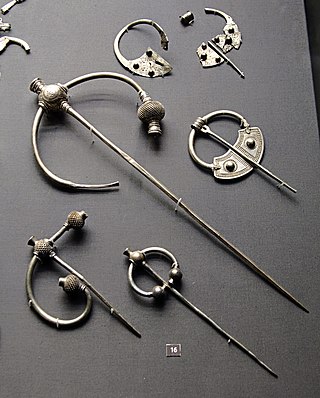
In Norse mythology, Huginn and Muninn are a pair of ravens that fly all over the world, Midgard, and bring information to the god Odin. Huginn and Muninn are attested in the Poetic Edda, compiled in the 13th century from earlier traditional sources: the Prose Edda and Heimskringla; in the Third Grammatical Treatise, compiled in the 13th century by Óláfr Þórðarson; and in the poetry of skalds. The names of the ravens are sometimes modernly anglicized as Hugin and Munin.

Vikings is the modern name given to seafaring people originally from Scandinavia, who from the late 8th to the late 11th centuries raided, pirated, traded and settled throughout parts of Europe. They also voyaged as far as the Mediterranean, North Africa, Volga Bulgaria, the Middle East, and North America. In their countries of origin, and some of the countries they raided and settled in, this period is popularly known as the Viking Age, and the term "Viking" also commonly includes the inhabitants of the Scandinavian homelands as a whole. The Vikings had a profound impact on the early medieval history of Scandinavia, the British Isles, France, Estonia, and Kievan Rus'.

A brooch is a decorative jewelry item designed to be attached to garments, often to fasten them together. It is usually made of metal, often silver or gold or some other material. Brooches are frequently decorated with enamel or with gemstones and may be solely for ornament or serve a practical function as a clothes fastener. The earliest known brooches are from the Bronze Age. As fashions in brooches changed rather quickly, they are important chronological indicators. In archaeology, ancient European brooches are usually referred to by the Latin term fibula.

Lindholm Høje is a major Viking burial site and former settlement situated to the north of and overlooking the city of Aalborg in Denmark.
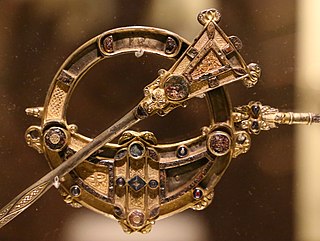
The Tara Brooch is an Irish Celtic brooch, dated to the late-7th or early-8th century, of the pseudo-penannular type. It is made from bronze, silver and gold, with a head formed from a circular ornate ring that is intricately decorated on both sides. Its upper half is hollow while the lower half is solid with fused terminals. The brooch was constructed from numerous individually made pieces, and its front and reverse sides are both decorated with around 50 inserted cast panels containing highly ornate filigree. The borders and terminals contain multiple panels holding multi-coloured studs, interlace patterns, filigree and Celtic spirals. The brooch is widely considered the most complex and ornate of its kind, and would have been commissioned to be worn as a fastener for the cloak of a high ranking cleric or as ceremonial insignia of high office for a High King of Ireland in Irish Early Medieval society.

Viking art, also known commonly as Norse art, is a term widely accepted for the art of Scandinavian Norsemen and Viking settlements further afield—particularly in the British Isles and Iceland—during the Viking Age of the 8th-11th centuries. Viking art has many design elements in common with Celtic, Germanic, the later Romanesque and Eastern European art, sharing many influences with each of these traditions.

Lagertha, according to legend, was a Viking ruler and shield-maiden from what is now Norway, and the onetime wife of the famous Viking Ragnar Lodbrok. Her tale was recorded by the chronicler Saxo in the 12th century. According to the historian Judith Jesch, Saxo's tales about warrior women are largely fictional; other historians wrote that they may have a basis in tales about the Norse deity Thorgerd.

The Celtic brooch, more properly called the penannular brooch, and its closely related type, the pseudo-penannular brooch, are types of brooch clothes fasteners, often rather large; penannular means formed as an incomplete ring. They are especially associated with the beginning of the Early Medieval period in Ireland and Britain, although they are found in other times and places—for example, forming part of traditional female dress in areas in modern North Africa.

Viking activity in the British Isles occurred during the Early Middle Ages, the 8th to the 11th centuries CE, when Scandinavians travelled to the British Isles to raid, conquer, settle and trade. They are generally referred to as Vikings, but some scholars debate whether the term Viking represented all Scandinavian settlers or just those who used violence.

Scandinavian Scotland was the period from the 8th to the 15th centuries during which Vikings and Norse settlers, mainly Norwegians and to a lesser extent other Scandinavians, and their descendants colonised parts of what is now the periphery of modern Scotland. Viking influence in the area commenced in the late 8th century, and hostility between the Scandinavian earls of Orkney and the emerging thalassocracy of the Kingdom of the Isles, the rulers of Ireland, Dál Riata and Alba, and intervention by the crown of Norway were recurring themes.

Art in Medieval Scotland includes all forms of artistic production within the modern borders of Scotland, between the fifth century and the adoption of the Renaissance in the early sixteenth century. In the early Middle Ages, there were distinct material cultures evident in the different federations and kingdoms within what is now Scotland. Pictish art was the only uniquely Scottish Medieval style; it can be seen in the extensive survival of carved stones, particularly in the north and east of the country, which hold a variety of recurring images and patterns. It can also be seen in elaborate metal work that largely survives in buried hoards. Irish-Scots art from the kingdom of Dál Riata suggests that it was one of the places, as a crossroads between cultures, where the Insular style developed.
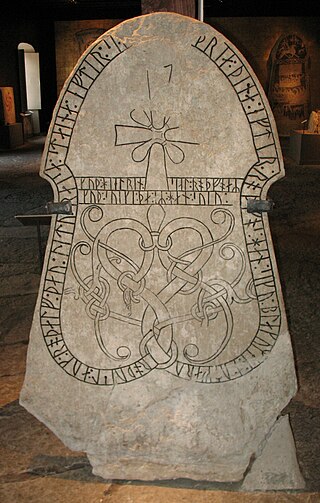
Blakumen or Blökumenn were a people mentioned in Scandinavian sources dating from the 11th through 13th centuries. The name of their land, Blokumannaland, has also been preserved. Victor Spinei, Florin Curta, Florin Pintescu and other historians identify them as Romanians, while Omeljan Pritsak argues that they were Cumans. Judith Jesch adds the possibility that the terms meant "black men", the meaning of which is unclear. Historians identify Blokumannaland as the lands south of the Lower Danube which were inhabited by Vlachs in the Middle Ages, adding that the term may refer to either Wallachia or Africa in the modern Icelandic language.
Judith Jesch is professor of Viking Age studies at the University of Nottingham. Jesch is chair of the international Runic Advisory Group and president of the English Place-Name Society.
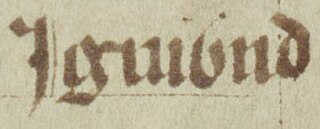
Ingimundr, also known as Hingamund, Igmunt, Ingimund, was a tenth century Viking warlord. In 902, Irish sources record that the Vikings were driven from Dublin. It is almost certainly in the context of this exodus that Ingimundr appears on record. He is recorded to have led the abortive settlement of Norsemen on Anglesey, before being driven out from there as well. He appears to have then led his folk to the Wirral peninsula, where the English allowed him to settle his followers. Ingimundr's invasion of Anglesey may be the most notable Viking attack in Welsh history.
Olwyn Owen, FSA Scot, is a British archaeologist and academic specialising in Scandianvian Scotland.

The Pentney Hoard is an Anglo-Saxon jewellery hoard, discovered by a gravedigger in a Pentney, Norfolk churchyard in 1978. The treasure consists of six silver openwork disc brooches, five made entirely of silver and one composed of silver and copper alloy. The brooches are decorated in the 9th century Trewhiddle style. The hoard is now in the British Museum.
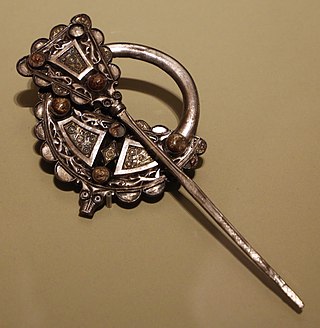
The Roscrea brooch is a 9th-century Celtic brooch of the pseudo-penannular type, found at or near Roscrea, County Tipperary, Ireland, before 1829. It is made from cast silver, and decorated with zoomorphic patterns of open-jawed animals and gilded gold filigree, and is 9.5 cm in height and 8.3 cm wide. The silver is of an unusually high quality for Irish metalwork of the period, indicating that its craftsmen were both trading materials with settled Vikings, who had first, traumatically, invaded the island in the preceding century, and had absorbed elements of the Scandinavian's imagery and metalwork techniques.
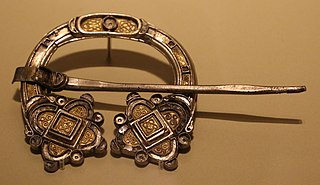
The Kilmainham Brooch is a late 8th- or early 9th-century Celtic brooch of the "penannular" type. With a diameter of 9.67 cm, it is a relatively large example, and is made from silver, gold and glass, with filigree and interlace decorations. Like other high-quality brooches of its class, it was probably intended to fasten copes and other vestments rather than for everyday wear, as its precious metal content would have made it a status symbol for its owner; less expensive Viking-style brooches were typically worn in pairs on women's clothing.








